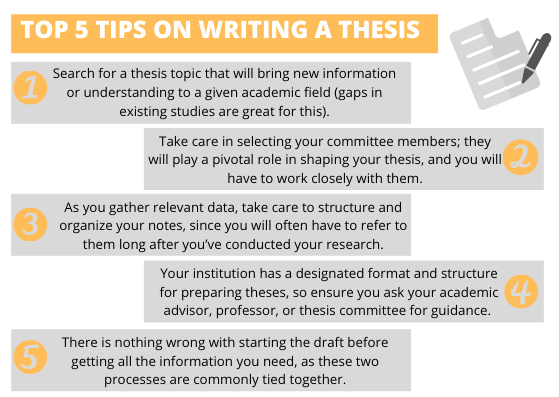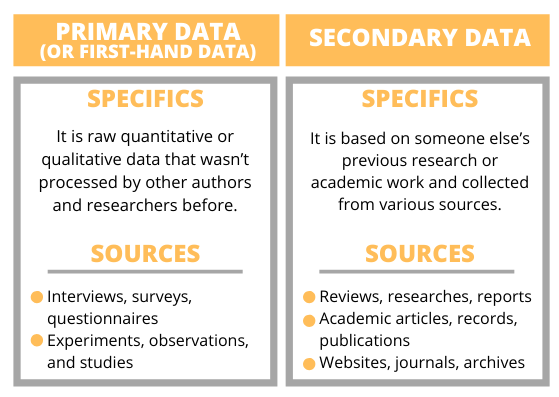How to Write a Thesis
Writing Guide
A large project that supports professional qualification or an academic degree is named a thesis paper. Theses are used to support, detail, and summarize a degree candidate’s research and findings. The complexity, length, and amount of time spent to perform such a work can vary by the type of degree, the university, or the academic program a degree candidate enrolls in.
The word “dissertation” is sometimes used to describe similar researched academic documents as well. For example, in the UK and countries of the EU, a thesis paper is a massive work written in support of obtaining a Ph. D. while a dissertation is written in pursuit of a master’s degree.
Types of Theses
There are a few types of thesis papers; the choice of thesis format often depends on the program of study and the thesis topic that the candidate or student selects. Here are three thesis types that degree candidates choose from.
1. Research Thesis
A research thesis is the most common type of thesis written. It presents research on a specific problem carried out over an extended time period. Research theses clearly specify the problem of the degree candidate’s research, the work carried out to reach a conclusion and the results obtained. A research thesis goes beyond a literature review and aims to bring new, significant findings to a given field of study.
2. Experiment or Project Thesis
Students in the fields of business, education, or social and behavioral studies often choose to perform an experiment or project thesis. Unlike other types of theses, project thesis papers require practical performance and evaluation instead of just proposing an experiment or project in a theory. This type of thesis commonly consists of two parts: part one is dedicated to the project or experiment itself (the steps and methods), while part two gives an interpretation and the author’s opinion on the results.
3. Art Thesis
An art thesis is a work submitted by degree candidates in a field of arts. In many art programs, for example, students might have to prepare and submit a short film, a series of artworks, or a literary work as their thesis project in order to obtain a degree. Many academic institutions require that the art piece be accompanied by written research related to the field of the project as well.

Steps of Writing a Thesis
Here are five of the most common steps taken in order to write a thesis. Keep in mind that the thesis selection and preparation process can vary considerably between different institutions and academic programs.
Step 1 – Select a Thesis Topic that Resonates with You
Unlike other types of academic work, thesis topics are not assigned by a teacher or professor; they are chosen by a student according to the academic program and the student’s personal interest in a given research topic. Though students typically have considerable latitude in selecting a thesis topic, there are several important matters they should take into consideration:
- Select a topic you are interested in researching and writing about.
- The earlier you select a thesis topic in an academic program, the better. Promptly selecting a topic will optimize the time you have available to collect data, conduct research, reach conclusions, and write your paper.
- The thesis topic you select should be substantial enough to require in-depth research, yet not so broad that it becomes difficult to maintain focus and draw meaningful conclusions.
- Search for a thesis topic that will bring new information or understanding to a given academic field; you should also search for gaps in existing studies where additional work can answer critical questions.
- Ask for advice on your thesis topic from an advisor or trusted professor. An experienced academic can often steer you away from problematic thesis topics, and focus you on required research that you are genuinely interested in.
- The topic of the thesis should represent a degree candidate’s mastery of his or her chosen academic field.
Once you have chosen the direction of your future work, you should write down a few questions related to the thesis topic of your choice. These questions will help you begin to formulate your hypothesis and assist you with an understanding of how to elaborate upon it through your subsequent work.
Buy Thesis
Step 2 – Pick the Members for Your Committee
Although composition may vary, thesis committees typically consist of a supervisor and two more members who oversee the thesis’s progress. The committee may also act as the examining committee at the thesis defense as well if the academic program requires it. In most cases, the degree candidate chooses his or her thesis committee, although the candidate’s academic advisor may assist with this effort in some programs.
Take care in selecting your committee members; they will play a pivotal role in shaping your thesis, and you will have to work closely with them over the course of your academic program. Select committee members who are respected experts in your chosen field. Take the prospective committee members’ personalities into consideration as well; you should choose people who are approachable, but who are nonetheless willing to challenge your conclusions and sharpen your arguments. Ensure that the committee members you choose are collegial with one another and that there is no personal or academic animosity between any of them.
Finally, you should make certain that any individual you select for your committee will be readily available while you conduct your work. Avoid choosing any committee members who may travel or transfer from the academic institution, or otherwise have limited availability to interact with you during your thesis work.
Step 3 – Start Your Research
Once you have selected a thesis topic and your academic program approves it, you should start collecting relevant information. There are two major types of data that are commonly used for thesis papers – primary and secondary data.
Primary data (or first-hand data) is information that you collect yourself specifically for your study. It is raw quantitative or qualitative data that wasn’t processed by other authors and researchers before. For example:
- Interviews, surveys, questionnaires
- Experiments, observations, and studies
Secondary data is based on someone else’s previous research and work. It can be data collected from various sources, including:
- Reviews, researches, reports
- Academic articles, records, publications
- Websites, journals, archives

While you will use both types of data in your work, the primary data you collect, analyze, and describe is essential to bringing new information to your chosen field of study. Primary data often takes considerable time, effort, and at times funding to gather, so keep that in mind as you plan how to conduct your research.
There are many sources of secondary data. If your academic institution has a research library, checking in with the librarians or researchers assigned, there is a good place to start on your search for information relevant to your study. Additionally, there are several online databases worth searching for secondary data as well, including:
As you gather relevant data, take care to structure and organize your notes, since you will often have to refer to them long after you’ve conducted your research. Also, while you will need to complete your research prior to drawing conclusions in your thesis, there is nothing wrong with starting the draft before getting all the information you need, as these two processes are commonly tied together.
Step 4 – Draft Your Thesis
Writing the first draft of your thesis is a challenging and time-consuming task. Your thesis draft must describe the problem you considered and the research you conducted and state your findings and conclusions in a clear and concise manner.
As discussed earlier, it is not necessary to have all of the needed data on hand when starting your thesis draft. However, keep in mind that the data you collect and research you conduct may later contradict your initial hypothesis. Therefore, as you begin writing your thesis draft, you should focus on preparing the more perfunctory parts of your thesis paper (see below), along with the chapters that you already have the most information for.
Your academic institution will likely have a designated format and structure for preparing theses, so ensure you ask your academic advisor, professor, or thesis committee for guidance prior to writing a draft. A common thesis structure is the IMRaD model (Introduction, Methods, Results, and Discussion), which includes the following chapters and sections:
- Cover page
- Preliminary Pages
- Acknowledgment
- Abstract
- Table of Contents
- List of Tables
- List of Figures
- Declaration of Originality (optional for particular learning institutions)
- Introduction
- Background
- Problematic
- Justification
- Research Questions and Methods
- Methods
- Results
- Discussion
- Comments on the Results
- Explanation and Interpretation of the Results
- Comparison with Related Works
- Conclusion
- Summary
- Suggestions for Future Research
- Appendix
- Bibliography
As you prepare to write your draft, keep in mind that you may be required to routinely turn in chapters or sections of the paper to your thesis committee for periodic review. In some cases, the committee may require you to conduct substantial edits of a thesis section; you may be directed to complete entire rewrites of sections as well. As you create a timeline for conducting your research and writing your draft, ensure you factor this review process into consideration.
Step 5 – Thesis Refinement: Editing, Proofreading, and Submission
Once you have completed a draft, and your committee has conducted its initial review, it is time to refine your thesis. It often takes as much time to revise and refine your thesis as it did to write the initial draft, since there is a substantial amount of work to complete during this step, including:
- Create your tables and figures. Give each table or figure a number and a short caption that describes it succinctly.
- Check your grammar and punctuation. You can use online services like Grammarly, or turn to a professional service for expert proofreading and thesis writing support.
- Review the text and search for incomplete sentences, misspelled or misused words, redundant phrasing, and unclear wording. Revise the text where required.
- Ensure you have enough evidence. Your opinion and conclusion should be well supported by the facts. If you are concerned about whether or not you have enough evidence, or the evidence you present is compelling enough, ask your academic advisor or thesis committee for advice.
- Define whether or not the paper has a logical flow. Ensure you use transitional sentences and words so that each of your paragraphs flows smoothly into the next one.
- Verify that your paper meets the word count and all of the other requirements of your learning institution.
- Check your work for plagiarism and proper citations and references. Websites like Duplichecker can help you ensure that your thesis is free of plagiarism and identify any of the paper’s sections that need proper citations.
- Proofread your work one more time before submitting it.
- Prepare for your thesis defense.
Once you have completed all of these steps, you should set your paper aside for a day or two. Then after you have achieved a bit of mental separation from your work and the text, you should proofread your thesis one final time, make any necessary adjustments or edits, and then submit it.
Conclusion
Writing an effective thesis is a critical part of many academic and professional education programs. The advice provided here can help you to better work with your academic institution to select a relevant thesis topic, choose an effective thesis committee, and research and write an impactful thesis paper. Good luck as you embark on a major milestone in your academic and professional career!

